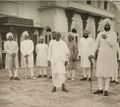Nabha
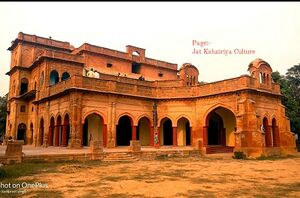
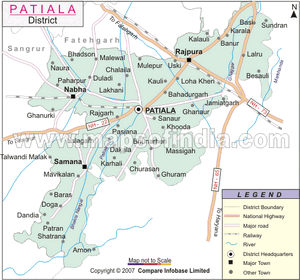
Nabha (Hindi:नाभा, Punjabi:ਨਾਭਾ) is a town and tahsil in Patiala district in Punjab, India. Nabha was a state of Siddhu Jats.
List of Nabha rulers

- Chuadhari Phul Singh (b.-d.1652)
- Tiloka (b.-d.1687)
- Gurudatta (b.-d.1744)
- Surat Singh (b.-d.1742)
- Hamir Singh of Nabha (1755-d.1783 )
- Raja Jaswant Singh (b.1775,r.1783-d.1840)
- Raja Devendra Singh (b.1822,r.1840-1846 deposed,d.1865)
- Raja Bharpur Singh (b.1840, r.1847-d.1863)
- Raja Bhagwan Singh (b.1842. r.1864-d.1871)
- Raja Hira Singh (adopted son)(b.1843, r.1871-1911)
- Maharaja Ripudaman Singh (b.1883, r. 1911-1923 deposed,d.1942)
- Maharaja Pratap Singh (b.1919,r.1923-1995)
- Maharaja Hanuwant Singh
Villages in Nabha tahsil
Abhepur, Achal, Agaul, Ageta, Ageti, Ajnauda Kalan, Ajnauda Khurd, Akalgarh, Alampur, Alhoran, Alipur, Allowal, Babarpur, Banera Kalan, Banera Khurd, Barhe, Bauran Kalan, Bauran Khurd, Bazidpur, Bazidri, Behbalpur, Bhadson, Bhari Panechan, Bhilowal, Bhojo Majri, Bhore, Bina Heri, Bir Agaul, Bir Bauran, Bir Bhadson, Bir Dosanjhan, Birarhwal, Birdhano, Bishangarh, Bishanpura, Bugga Khurd, Chahal, Chaswal, Chathe, Chhaju Bhatt, Chhana Nathuwali, Choudhri Majra, Dakaunda, Dandrala Dhindsa, Dandrala Kharaur, Dargapur, Dewangarh, Dhanaura, Dhanauri, Dhanauri, Dhangera, Dharoki, Dhingi, Dhundewal, Dittupur Jattan, Doda, Duladi, Faizgarh, Faridpur, Fatehpur, Gadaya, Galwati, Ghamrouda, Ghaniawal, Ghanurki, Ghunder, Gobindgarh Chhanna, Gobindpura, Gujarheri, Gunike, Gurditpura, Hakimpur, Halla, Halotali, Hari nagar, Harigarh, Hassanpur, Hiana Kalan, Hiana Khurd, Ichhewal, Jasso Majra, Jatiwal, Jhambali Khas, Jhambali Sahni, Jindalpur, Kaidupur, Kakrala, Kalar Majri, Kalhana, Kalhe Majra, Kalsana, Kameli, Kansuha Kalan, Kansuha Khurd, Kaul, Khanora, Kheri Jattan, Khizarpur, Khokh, Khurd, Kishangarh, Kot Kalan, Kot Khurd, Kotli, Kularan, Labana Karmoo, Labana Teku, Ladha Heri, Lalauda, Lohar Majra, Lopa, Lout, Malewal, Malkon, Mandaur, Mangewal, Mansurpur, Matourda, Mehas, Mohal Gawara, Mungo, Nabha (M Cl), Nabha (Rural), Nanoki, Nanowal, Naraingarh, Narmana, Nauhra, Paharpur, Pahlia Kalan, Pahlia Khurd, Paidan, Paidni Khurd, Raimal Majri, Raisal, Raj Garh, Rajpura, Ramgarh, Ramgarh, Ramgarh Chhanna, Rampur Sahiewal, Ramsingh Nau, Ranjitgarh, Ranno, Rohta, Rohti Basta Singh, Rohti Chhanna, Rohti Khas, Rohti Mouran, Sadhnauli, Sadho Heri, Sahauli, Sakohan, Sakrali, Saluwala, Sangatpura, Sauja, Shahpur, Shamaspur, Shamla, Shivgarh, Simbhron, Siri Nagar, Sudhewal, Sukhewal, Suraajpur, Tarkheri Kalan, Tarkheri Khurd, Thuhi, Todarwal, Tohra, Tungan, Udha, Uplan,
सिद्धू - बराड़ जाटवंश
दलीप सिंह अहलावत [1] के अनुसार ये दोनों जाटवंश (गोत्र) चन्द्रवंशी मालव या मल्ल जाटवंश के शाखा गोत्र हैं। मालव जाटों का शक्तिशाली राज्य रामायणकाल में था और महाभारतकाल में इस वंश के जाटों के अलग-अलग दो राज्य, उत्तरी भारत में मल्लराष्ट्र तथा दक्षिण में मल्लदेश थे। सिकन्दर के आक्रमण के समय पंजाब में इनकी विशेष शक्ति थी। मध्यभारत में अवन्ति प्रदेश पर इन जाटों का राज्य होने के कारण उस प्रदेश का नाम मालवा पड़ा। इसी तरह पंजाब में मालव जाटों के नाम पर भटिण्डा, फरीदकोट, फिरोजपुर, लुधियाना आदि के बीच के प्रदेश का नाम मालवा पड़ा। (देखो, तृतीय अध्याय, मल्ल या मालव, प्रकरण)।
जब सातवीं शताब्दी में भारतवर्ष में राजपूत संघ बना तब मालव या मलोई गोत्र के जाटों के भटिण्डा में भट्टी राजपूतों से भयंकर युद्ध हुए। उनको पराजित करके इन जाटों ने वहां पर अपना अधिकार किया। इसी वंश के राव सिद्ध भटिण्डा नामक भूमि पर शासन करते-करते मध्य भारत के सागर जिले में आक्रान्ता होकर पहुंचे। इन्होंने वहां बहमनीवंश के फिरोजखां मुस्लिम शासक को ठीक समय पर सहायता करके अपना साथी बना लिया था जिसका कृतज्ञतापूर्वक उल्लेख शमशुद्दीन बहमनी ने किया है। इस लेखक ने राव सिद्ध को सागर का शासनकर्त्ता सिद्ध किया है। राव सिद्ध मालव गोत्र के जाट थे तथा राव उनकी उपाधि थी। इनके छः पुत्रों से पंजाब के असंख्य सिद्धवंशज जाटों का उल्लेख मिलता है। राव सिद्ध अपने ईश्वर विश्वास और शान्तिप्रियता के लिए विख्यात माने जाते हैं। राव सिद्ध से चलने वाला वंश ‘सिद्धू’ और उनकी आठवीं पीढ़ी में होने वाले सिद्धू जाट गोत्री राव बराड़ से ‘बराड़’ नाम पर इन लोगों की प्रसिद्धि हुई। राव बराड़ के बड़े पुत्र राव दुल या ढुल बराड़ के वंशजों ने फरीदकोट और राव बराड़ के दूसरे पुत्र राव पौड़ के वंशजों ने पटियाला, जींद, नाभा नामक राज्यों की स्थापना की। जब पंजाब पर मिसलों का शासन हुआ तब राव पौड़ के वंश में राव फूल के नाम पर इस वंश समुदाय को ‘फुलकिया’ नाम से प्रसिद्ध किया गया। पटियाला, जींद, नाभा रियासतें भी फुलकिया राज्य कहलाईं। बाबा आला सिंह संस्थापक राज्य पटियाला इस वंश में अत्यन्त प्रतापी महापुरुष हुए। राव फूल के छः पुत्र थे जिनके नाम ये हैं - 1. तिलोक 2. रामा 3. रुधू 4. झण्डू 5. चुनू 6. तखतमल। इनके वंशजों ने अनेक राज्य पंजाब में स्थापित किए।
जाट वीरों का इतिहास: दलीप सिंह अहलावत, पृष्ठान्त-774
फुलकिया से सम्बन्धित कैथल और अरनौली राज्य थे। इनके अतिरिक्त भदौड़, झुनवा, अटारी आदि छोटी-छोटी रियासतें भी सिद्धू जाटों की थीं। यही वंश पंजाब में सर्वाधिक प्रतापी है और सम्पूर्णतया धर्म से सिक्ख है।
राव सिद्धू के पुत्र राव भूर बड़े साहसी वीर योद्धा थे। अपने क्षेत्र के भट्टी राजपूतों से इसने कई युद्ध किए। इसी तरह से राव भूर से सातवीं पीढ़ी तक के इस सिद्धूवंश के वीर जाटों ने भट्टी राजपूतों से अनेक युद्ध किए। भट्टी राजपूत नहीं चाहते थे कि हमारे रहते यहां कोई जाट राज्य जमे या जाट हमसे अधिक प्रभावशाली बनकर रहें किन्तु राव सिद्धू की आठवीं पीढ़ी में सिद्धू गोत्र का जाट राव बराड़ इतना लड़ाकू शूरवीर, सौभाग्यशाली योद्धा सिद्ध हुआ कि उसने अपनी विजयों द्वारा राज्यलक्ष्मी को अपनी परम्परा में स्थिर होने का सुयश प्राप्त किया। यहां तक कि फक्करसर, कोट लद्दू और लहड़ी नामक स्थानों पर विजय प्राप्त करने पर तो यह दूर-दूर तक प्रख्यात हो गया। राव बराड़ के नाम पर सिद्धूवंशज बराड़वंशी कहलाने लगे। आजकल के सिद्धू जाट अपने को बराड़वंशी कहलाने में गौरव अनुभव करते हैं। इस वीर योद्धा राव बराड़ के दो पुत्र थे। बड़े का नाम राव दुल (ढुल) और छोटे का नाम राव पौड़ था।
इन दोनों की वंशपरम्परा में पंजाब में निम्न राज्य स्थापित किए ।
History

The Originator of the Phulkian Dynasty, Phul of Siddhu-Barad Jat clan, left six sons, of whom Tiloka was the eldest, and from him are descended the families of Jind and Nabha.[2]
From Rama, the second son, sprang the greatest of the Phulkian houses, that of Patiala besides Bhadaur, Kot Duna and Malaudh .[3]
In 1627 Phul founded and gave his name to a village which was an important town in the State of Nabha. His two eldest sons founded Bhai Rupa while Rama also built Rampura Phul.
Claiming descent from Jaisal, founder of the State of Jaisalmer in 1156, the founder of this Jat Sikh dynasty, Phul, was Chaudhri (Governor) of a country located at the south east of Delhi.
Phul’s descendants founded 3 States: Patiala, Jind and Nabha.

Nabha was a state of Siddhu Jats founded by grandson of Chaudhary Phul Singh in 1755.
- Phul Singh had six sons namely, 1.Tiloka 2.Ram Singh 3.Rudh 4.Chunu 5. Jhandu and 6.Takhtmal.
- Tiloka had two sons namely, 1. Gurudutta 2. Sukh Chain.
- Sukh Chain's descendants ruled Jind state
- Gurudatta's descendants ruled Nabha state.
- Gurudatta's only son was Surat Singh. Surat Singh died in 1742 prior to Gurudatta in 1744.
- Surat Singh had two sons 1. Hamir Singh (1755-1783 ) and 2. Kapur Singh.
- Hamir Singh's son Raja Jaswant Singh (1783-1840) became the ruler. He had two sons namely 1. Raja Devendra Singh and 2. Ranjit Singh.
- Raja Devendra Singh had two sons namely, 1. Raja Bharpur Singh and 2. Raja Bhagwan Singh.
- Raja Bharpur Singh died in 1863 prior to Raja Devendra Singh.
- Raja Bhagwan Singh ruled from 1864-1871. He had no son, so he adopted Raja Hira Singh (1871-1911).
- Raja Hira Singh ruled from 1871-1911. He was honoured with G.C.S.I. and G.C.I.I. titles by British. His only son was Maharaja Ripudaman Singh.
- Maharaja Ripudaman Singh (1911-1923) (1911-1923) or Gurcharan Singh, became ruler in 1912 after Raja Hira Singh.
- Maharaja Pratap Singh (1923-1995) born in 1919 was only son of Maharaja Ripudaman Singh.
The town of Nabha was formerly the capital of the eponymous princely state in the British Raj: Its territories were scattered; one section, divided into twelve separate tracts, was intersperced among the territories of Patiala and Jind, in the east and south of the Punjab; the other section was in the extreme southeast of that province. The whole of the territories physically belonged to a plain; however, they varied in character from the great fertility of the Pawadh region to the aridity of the Rajputana desert.
The first relations of the state with the HEIC occurred in 1807-08, when the raja obtained protection against the threatened encroachments of Ranjit Singh. After India's independence, Nabha united with four other Phulkian states to form the Patiala and East Punjab States Union (PEPSU), which later merged into Punjab state.
Lal Haveli, Nabha

This Beautiful red coloured Haveli was built by Sidhu Jat ruler H.H. Maharaja Hira Singh of Nabha in early 20th century. He used to come here for hunting.[4]
लाल हवेली, नाभा: इस खूबसूरत हवेली को 20 वीं सदी की शुरुआत में नाभा के सिद्धू जाट शासक एच.एच. महाराजा हिरा सिंह द्वारा बनाया गया था। वह शिकार करने के लिए यहां आते थे।
Nabha family, the eldest branch of the Phulkians
Lepel H. Griffin[5] gives following details:
The Nabha Chiefs claim precedence over the other Phulkian houses on account of their descent from the eldest branch of the family. The histories of Pattiala and Jhind have contained an account of the common ancestor Phul, and of his two sons Gurditta and Sukhchen, from the elder of whom the Nabha house has sprung, and from the younger the house of Jhind.
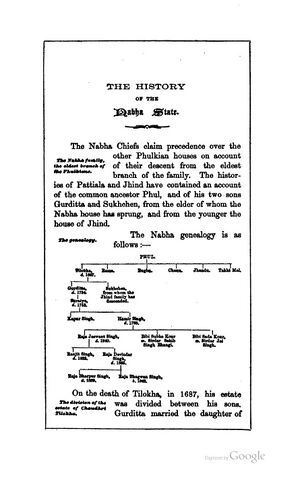
The Nabha genealogy is as pictured:
The division of the estate of Chaudhari Tiloka:
On the death of Tilokha, in 1687, his estate was divided between his sons. Gurditta married the daughter of
Sirdar Sardul Singh Man of Mauran, who bore him one son, Suratya. He founded the village of Dhanaula or Dhandla, on that portion of the estate of his father that fell to his share, and, subsequently, the town of Sangrur, which remained the head quarters of the Nabha State, till seized by treachery by the Raja of Jhind, and he also took from his neighbours a considerable portion of the surrounding country. He was always on bad terms with his younger brother Sukhchen, and on more than one occasion their disputes ended in bloodshed
The death of Gurditta and succession of Hamir Singh
He died in 1754, and was succeeded by his grandson Hamir Singh, his only son Suratya having died two years earlier, leaving two sons, Hamir Singh and Kapur Singh. Kapur Singh married Raj Kour, the daughter of Sujan Singh Mansahia, but died without issue, and his brother, in accordance with the Sikh custom of Karewa or chaddardalna, married the widow and succeeded to his brother's estate of Kapurgarh and Sangrur, which he had increased by the addition of the villages of Pakho and Badyala. This lady was the only one of Hamir Singh's wives who bore him a son, Jaswant Singh, born in the year 1775. The Chief married, besides, a daughter of Natha Singh, Magharia ; Desu, the daughter of Sirdar Makhan Singh of Rori, who gave birth to two daughters, Subha Kour and Sada Kour, the former of whom was married to Sirdar Sahib Singh,* the powerful Bhangi Chief, and the latter to Sirdar Jai Singh of Batala. His fourth wife Raj
* Translation of replies of the Nabha Ahlkars in the Mowran case 18th May 1844, and the Bhangi History, it is curious that both the Nabha and Bhadour family histories make Subha Kour the wife of Sardar Gujar Singh Bhangi, which is quite erroneous.
Kour, the daughter of Sirdar Dhan Singh of Nirhana, had no children. Hamir Singh was a brave and energetic Chief and added very largely to his
The town of Nabha founded, AD 1755
He founded the town of Nabha in the year 1755 ; four years later he obtained possession of Bhadson, and, in 1763, having joined Raja Ala Singh of Pattiala and the other Sikh Chiefs in the great battle of Sirhind, when Zin Khan, the Muhammadan Governor, was slain, he obtained Imloh or Amloh as his share of the spoil. He conquered Rori from Rahimdad Khan in 1776. Hamir Singh was the first Chief of Nabha who established a mint,* which may be accepted as a sign of his complete independence. Many of the successes of Nabha at this time were due to the ability of a Muhammadan Diwan of the Raja's, popularly known as “Kubba” or the hump-backed.
The conquest of Sangrur by the Raja of Jhind:
Hamir Singh was not invariably fortunate, and in Raja Gajpat Singh of Jhind he found more than his match. In 1774, the later chief invaded Nabha on a frivolous pretext, took Hamir Singh prisoner by treachery, and seized the strong town of Sangrur, which has never been restored.†
The death of Hamir Singh AD 1783, and the regency of Mai Deso:
When Hamir Singh died in 1783, his son Jaswant Singh was only eight years of Age and it was necessary to appoint a Regent to carry on the administration. Rani Desu, one of the late Chiefs widows, was selected on account of her capacity for business, in preference to the mother of Jaswant Singh. Desu
* Ante p. 317.
† Ante p. 318—315.
had held her own bravely against Jhind during the imprisonment of her husband, recovering most of the territory which had been seized by Raja Gajpat Singh, with the aid of troops lent by her son-in-law Sirdar Sahib Singh Bhangi of Gujrat.
The death Mai Desu:
With these foreign troops she maintained herself as regent, ruling in the name Of her son till 1790, when she died suddenly : her enemy and rival Raja Gajpat Singh at Jhind having died in the previous year.
The expedition against George Thomas:
After this, the relations between Nabha and Jhind became more friendly, and a common danger for the time united them in an attempt to destroy the power of George Thomas, the master of Hansi, whose wars and conquests, so far as they concerned the Cis-Satlej States, have been already related,*
The price of Mahratta existence:
In the arrangements made at Dehli with General Perron, the Commander-in-Chief of the Northom Mahratta army, for the expulsion of Thomas from Hansi, it does not appear that Nabha was concerned.† The Agents of the Raja of Pattiala, Raja Bhag Singh of Jhind, and Bhai Lal Singh of Kythal, were the contracting parties, but Nabha was included in the conditions finally settled, as that State would benefit as much as any other from the defeat of the common enemy.
The revenue and tribute promised to be paid to the Mahrattas by the Sikhs, who were strangely willing to surrender their independence, is given in the following list, which shows fairly the relative power and resources of the several Cis-Satlej States at the close of the last century.
* Ante p. 81. †t Ante p. 88.
Maharaja Pratap Singh of Nabha
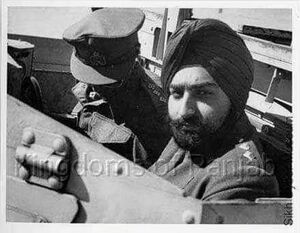
Lt H.H Maharaja Pratap Singh of Nabha photographed inside an universal carrier somewhere in the Middle East during the Second World War.
He was the last ruling king of Nabha, an erstwhile princely state of Punjab, and served as aide-de-camp to the President of India following Indian Independence in 1947. He also gave his services as the head of the Sikh Regiment.
Maharaja Nabha formed Wildlife Preservation Society of India in 1958 and remained it's president till his last Breath.
Maharani Nabha was a very spiritual lady. She took keen interest in the development of religious shrines of Nabha state.
Notable persons
Gallery
-
Maharaja Pratap Singh of Nabha along with his wife Maharani Urmilla Devi Sahiba of Dholpur
-
Maharaja Pratap Singh of Nabha
-
Hira Mahal, Nabha
-
Tikka Sahib Shri Hanuwant Singh Bahadur of Nabha. Credit:- Kingdoms of Panjab
-
Maharaja Pratap Singh of Nabha with his youngest son Maharajkumar Shri Himmat Singh, State:- Nabha, Dynasty:- Sidhu Jat, Credit:- Kunwar Bhanu Pratap Singh of Nabha
-
Maharaja Hira Singh, Maharaja Of Nabha at Delhi Durbar 1903
-
The guest house building of Nabha State that was converted into Junior wing of Punjab Public School in 1961. This majestic building has massive rooms and exquisite fireplaces. Source - Jat Kshatriya Culture
-
Inside view of Rani Mahal, Nabha. Source - Jat Kshatriya Culture
-
Maharaja Yadavindra Singh of Patiala, Maharaja Ranbir Singh Of Jind, Maharaja Jagatjit Singh of Kapurthala Maharaja Pratap Singh of Nabha, Maharaja Sir Harinder Singh Brar of Faridkot with Sardar Vallabhai Patel
-
Prince Ripudaman Singh of Nabha, later Maharaja of Nabha (1883-1942) with State Officials
-
Maharaj Kumar Abhyudaypratap Singh. Great grand son of Maharaja Pratap Singh of Nabha
-
H.H.Maharaja Hira Singhji Maharaja of Nabha,
-
Colonel Maharaja Hira Singhji (1843-1911) and his son, Tikka Ripudaman Singhji of Nabha, Dynasty - Sidhu, Source - Jat Kshatriya Culture
-
This portrait of last ruling His Highness Maharaja Pratap Singh of Nabha, was drawn by an unknown painter in the year of 1942. The specific diamond necklace signifies occasion of coronation.
External links
References
- ↑ Jat History Dalip Singh Ahlawat/Chapter IX, pp. 774-775
- ↑ Latif, S.M., History of the Punjab
- ↑ A collection of treaties, engagements, and sunnuds, relating to India By India Foreign and Political Dept, Charles pp.274
- ↑ Jat Kshatriya Culture
- ↑ The Rajas of the Punjab by Lepel H. Griffin/The History of the Nabha State, pp.417-











